2016 HONDA CIVIC COUPE window
[x] Cancel search: windowPage 4 of 585

Contents
Child Safety P. 58 Exhaust Gas Hazard P. 70 Safety Labels P. 71
Opening and Closing the Trunk P. 133 Security System P. 136 Opening and Closing the Windows P. 139
Operating the Switches Around the Steering Wheel P. 143 Adjusting the Mirrors P. 157
Interior Lights/Interior Convenience Items P. 168 Climate Control System P. 179
Audio Error Messages P. 283 General Information on the Audio System P. 286
When Driving P. 386 Braking P. 445 Parking Your Vehicle P. 461
Fuel Economy P. 467 Accessorie s and Modifications P. 468
Maintenance Under the Hood P. 483 Replacing Light Bulbs P. 498
Checking and Maintaining Tires P. 510 Battery P. 519 Remote Transmitter Care P. 521
Cleaning P. 524
Engine Does Not Start P. 537 Jump Starti ng P. 540 Shift Lever Does Not Move P. 543
Fuses P. 552 Emergency Towing P. 556 When You Cannot Unlock the Fuel Fill Door P. 557
Devices that Emit Radio Waves P. 567 Reporting Safety Defects P. 568
Authorized Manuals P. 573 Customer Service Information P. 574
Quick Reference GuideP. 4
Safe DrivingP. 31
Instrument PanelP. 73
ControlsP. 113
FeaturesP. 187
DrivingP. 379
MaintenanceP. 469
Handling the UnexpectedP. 529
InformationP. 561
IndexP. 575
16 CIVIC 2D HC2 (0A 01 0C)-31TBG6000.book 3 ページ >0>.>/6年>0月>/>0日 金曜日 午後4時>/6分
Page 5 of 585
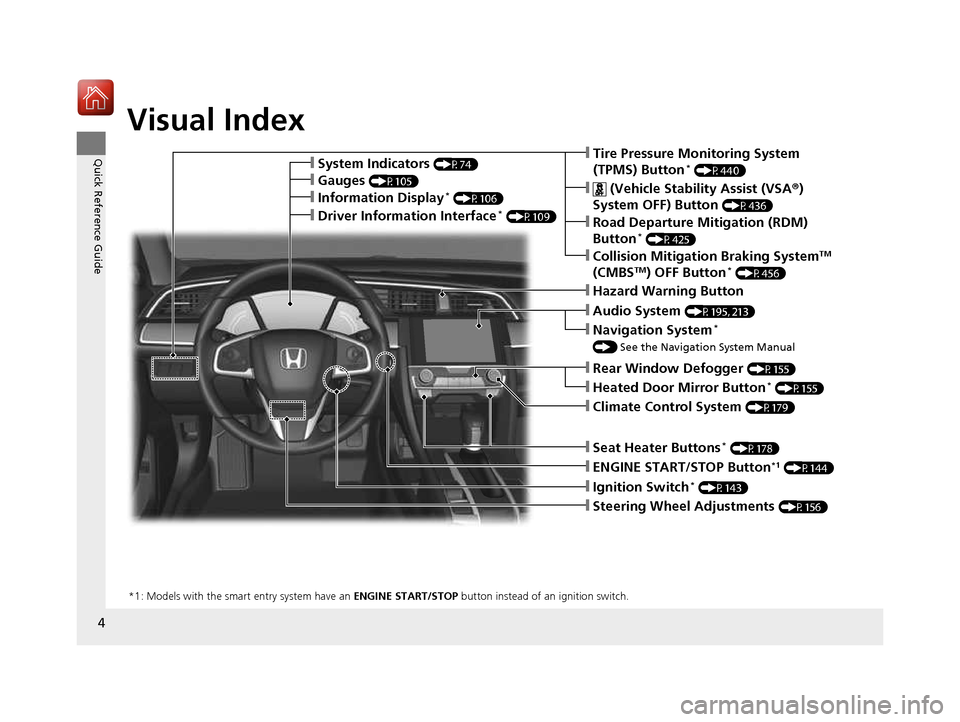
4
Quick Reference Guide
Quick Reference Guide
Visual Index
❙Ignition Switch*
(P143)
❙ENGINE START/STOP Button *1
(P144)
*1: Models with the smart entry system have an ENGINE START/STOP button instead of an ignition switch.
❙Tire Pressure Monitoring System
(TPMS) Button*
(P440)
❙Information Display *
(P106)
❙System Indicators (P74)
❙Gauges (P105)
❙Collision Mitigation Braking System TM
(CMBS TM
) OFF Button *
(P456)
❙ (Vehicle Stability Assist (VSA ®)
System OFF) Button (P436)
❙Road Departure Mitigation (RDM)
Button*
(P425)
❙Navigation System *
() See the Navigation System Manual
❙Audio System (P195, 213)
❙Hazard Warning Button
❙Rear Window Defogger (P155)
❙Heated Door Mirror Button *
(P155)
❙Climate Control System (P179)
❙Seat Heater Buttons*
(P178)
❙Steering Wheel Adjustments (P156)
❙Driver Information Interface*
(P109)
16 CIVIC 2D HC2 (0A 01 0C)-31TBG6000.book 4 ページ >0>.>/6年>0月>/>0日 金曜日 午後4時>/6分
Page 7 of 585
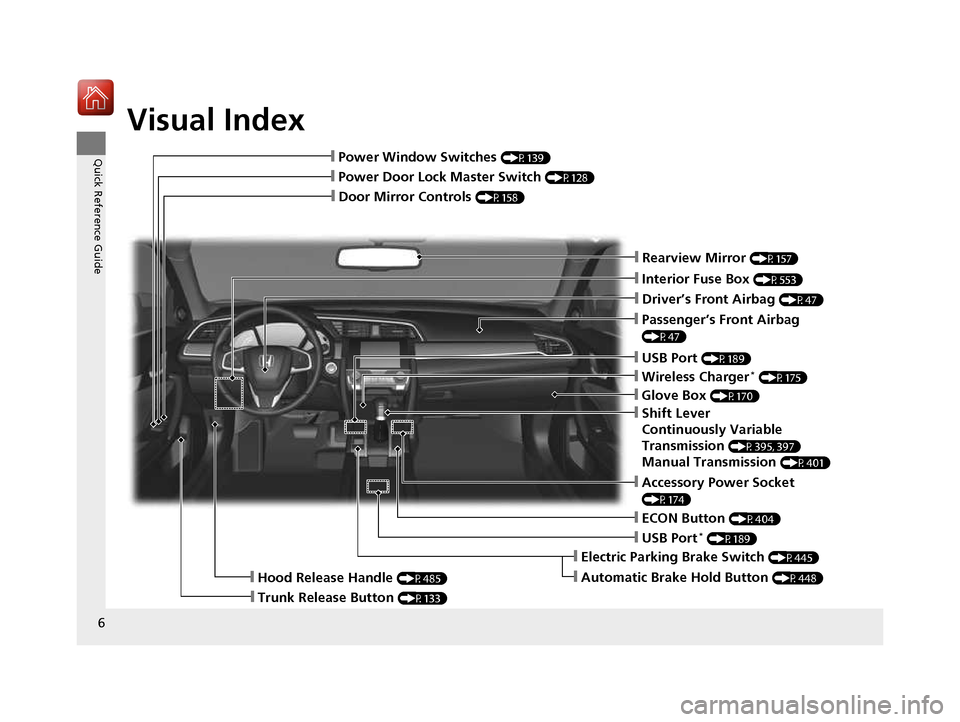
Visual Index
6
Quick Reference Guide
❙Door Mirror Controls (P158)
❙Passenger’s Front Airbag
(P47)
❙Glove Box (P170)
❙Rearview Mirror (P157)
❙Accessory Power Socket
(P174)
❙Hood Release Handle (P485)
❙Trunk Release Button (P133)
❙Power Door Lock Master Switch (P128)
❙Power Window Switches (P139)
❙Interior Fuse Box (P553)
❙Driver’s Front Airbag (P47)
❙USB Port (P189)
❙Shift Lever
Continuously Variable Transmission (P395, 397)
Manual Transmission (P401)
❙ECON Button (P404)
❙Electric Parking Brake Switch (P445)
❙Automatic Brake Hold Button (P448)
❙USB Port*
(P189)
❙Wireless Charger *
(P175)
16 CIVIC 2D HC2 (0A 01 0C)-31TBG6000.book 6 ページ >0>.>/6年>0月>/>0日 金曜日 午後4時>/6分
Page 16 of 585
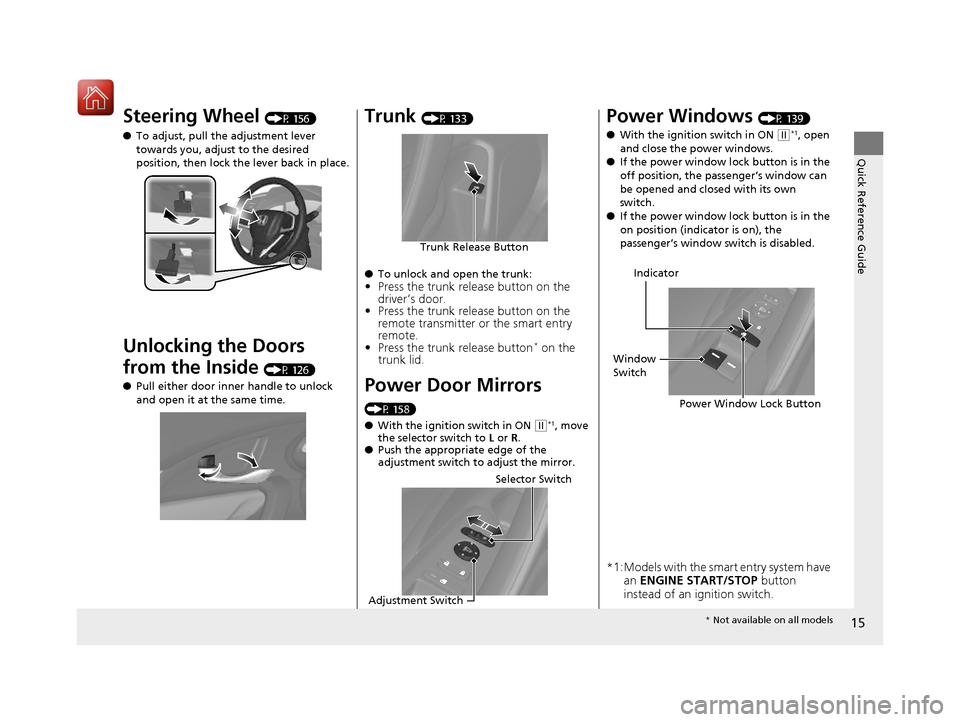
15
Quick Reference Guide
Steering Wheel (P 156)
● To adjust, pull the adjustment lever
towards you, adjust to the desired
position, then lock the lever back in place.
Unlocking the Doors
from the Inside (P 126)
● Pull either door inner handle to unlock
and open it at the same time.Trunk (P 133)
● To unlock and open the trunk:
• Press the trunk release button on the
driver’s door.
• Press the trunk release button on the
remote transmitter or the smart entry
remote.
• Press the trunk release button *
on the
trunk lid.
Power Door Mirrors
(P 158) ● With the ignition switch in ON
(w*1
, move
the selector switch to L or R.
● Push the appropriate edge of the
adjustment switch to adjust the mirror.
Trunk Release Button
Selector Switch
Adjustment Switch
Power Windows (P 139)
● With the ignition switch in ON
(w*1
, open
and close the power windows.
● If the power window lock button is in the
off position, the passenger’s window can
be opened and closed with its own switch.
● If the power window lock button is in the
on position (indicator is on), the
passenger’s window switch is disabled.
*1:Models with the smart entry system have an ENGINE START/STOP button
instead of an ignition switch.
Power Window Lock Button
Window
Switch Indicator
*
Not available on all models
16 CIVIC 2D HC2 (0A 01 0C)-31TBG6000.book 15 ページ >0>.>/6年>0月>/>0日 金 曜日 午後4時>/6分
Page 46 of 585
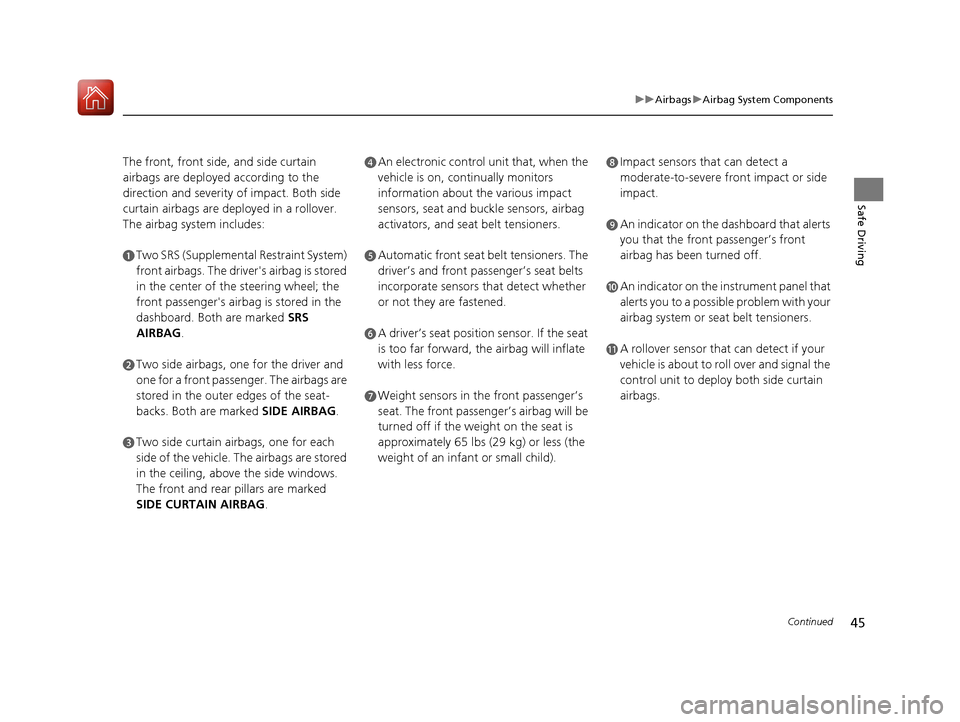
45
uuAirbagsuAirbag System Components
Continued
Safe Driving
The front, front side, and side curtain
airbags are deployed according to the
direction and severity of impact. Both side
curtain airbags are deployed in a rollover.
The airbag system includes:
aTwo SRS (Supplemental Restraint System)
front airbags. The driver's airbag is stored
in the center of the steering wheel; the
front passenger's airbag is stored in the
dashboard. Both are marked SRS
AIRBAG .
bTwo side airbags, one for the driver and
one for a front passenger. The airbags are
stored in the outer edges of the seat-
backs. Both are marked SIDE AIRBAG.
cTwo side curtain ai rbags, one for each
side of the vehicle. The airbags are stored
in the ceiling, above the side windows.
The front and rear pillars are marked
SIDE CURTAIN AIRBAG .
dAn electronic control unit that, when the
vehicle is on, continually monitors
information about the various impact
sensors, seat and buckle sensors, airbag
activators, and seat belt tensioners.
eAutomatic front seat belt tensioners. The
driver’s and front passenger’s seat belts
incorporate sensors that detect whether
or not they are fastened.
fA driver’s seat position sensor. If the seat
is too far forward, the airbag will inflate
with less force.
gWeight sensors in the front passenger’s seat. The front passenger’s airbag will be
turned off if the weight on the seat is
approximately 65 lbs (29 kg) or less (the
weight of an infant or small child).
hImpact sensors that can detect a
moderate-to-severe front impact or side impact.
iAn indicator on the dashboard that alerts
you that the front passenger’s front
airbag has been turned off.
jAn indicator on the instrument panel that
alerts you to a possible problem with your
airbag system or seat belt tensioners.
kA rollover sensor that can detect if your
vehicle is about to ro ll over and signal the
control unit to deploy both side curtain airbags.
16 CIVIC 2D HC2 (0A 01 0C)-31TBG6000.book 45 ページ >0>.>/6年>0月>/>0日 金 曜日 午後4時>/6分
Page 48 of 585
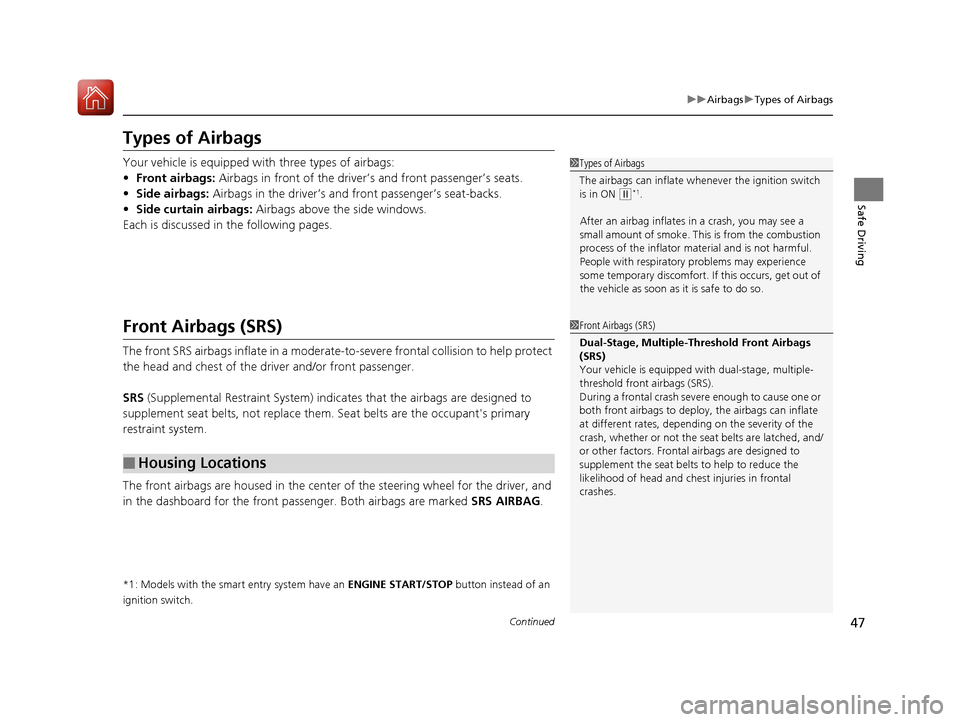
47
uuAirbagsuTypes of Airbags
Continued
Safe Driving
Types of Airbags
Your vehicle is equipped with three types of airbags:
• Front airbags: Airbags in front of the driver’s and front passenger’s seats.
• Side airbags: Airbags in the driver’s and front passenger’s seat-backs.
• Side curtain airbags: Airbags above the side windows.
Each is discussed in the following pages.
Front Airbags (SRS)
The front SRS airbags inflate in a moderate-to-severe frontal collision to help protect
the head and chest of the driver and/or front passenger. SRS (Supplemental Restraint System) indica tes that the airbags are designed to
supplement seat belts, not replace them . Seat belts are the occupant's primary
restraint system.
The front airbags are housed in the center of the steering wheel for the driver, and
in the dashboard for the front pass enger. Both airbags are marked SRS AIRBAG.
*1: Models with the smart entry system have an ENGINE START/STOP button instead of an
ignition switch.
■Housing Locations
1Types of Airbags
The airbags can inflate whenever the ignition switch
is in ON
(w *1
.
After an airbag inflates in a crash, you may see a
small amount of smoke. This is from the combustion
process of the infl ator material and is not harmful.
People with respiratory pr oblems may experience
some temporary discomfort. If this occurs, get out of
the vehicle as soon as it is safe to do so.
1Front Airbags (SRS)
Dual-Stage, Multiple-Threshold Front Airbags
(SRS)
Your vehicle is equipped wi th dual-stage, multiple-
threshold front airbags (SRS).During a frontal crash severe enough to cause one or
both front airbags to deploy, the airbags can inflate
at different rates, dependi ng on the severity of the
crash, whether or not the se at belts are latched, and/
or other factors. Frontal airbags are designed to
supplement the seat belts to help to reduce the
likelihood of head and chest injuries in frontal
crashes.
16 CIVIC 2D HC2 (0A 01 0C)-31TBG6000.book 47 ページ >0>.>/6年>0月>/>0日 金 曜日 午後4時>/6分
Page 54 of 585
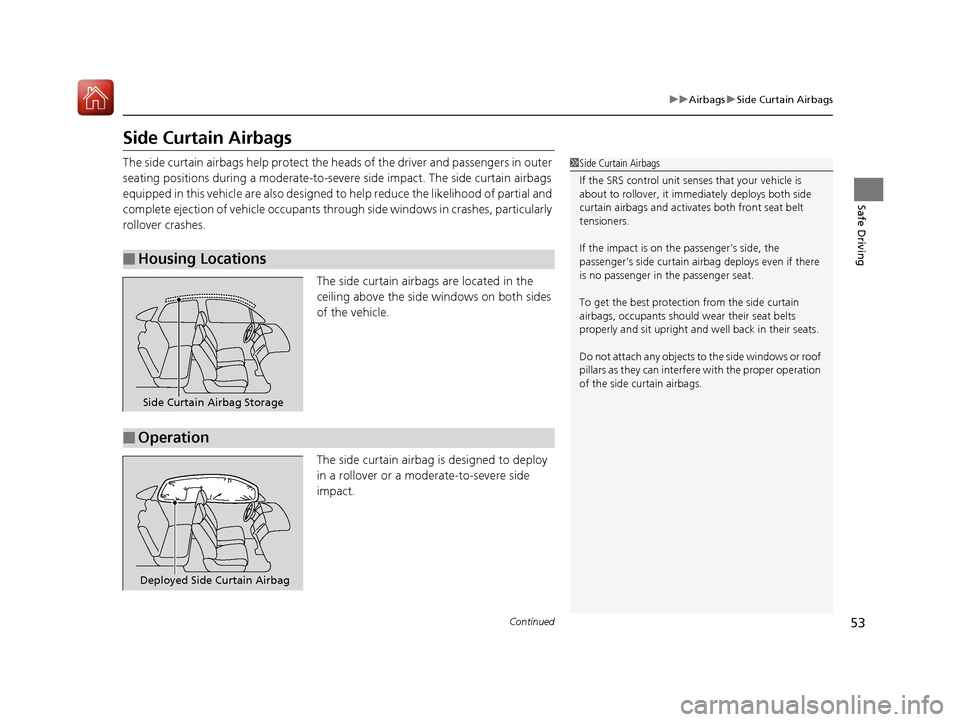
53
uuAirbagsuSide Curtain Airbags
Continued
Safe Driving
Side Curtain Airbags
The side curtain airbags help protect the heads of the driver and passengers in outer
seating positions during a moderate-to-severe side impact. The side curtain airbags
equipped in this vehicle are also designed to help reduce the likelihood of partial and
complete ejection of vehicle occupants through side windows in crashes, particularly rollover crashes.
The side curtain airbags are located in the
ceiling above the side windows on both sides
of the vehicle.
The side curtain airbag is designed to deploy
in a rollover or a moderate-to-severe side impact.
■Housing Locations
1Side Curtain Airbags
If the SRS control unit sens es that your vehicle is
about to rollover, it imme diately deploys both side
curtain airbags and activates both front seat belt
tensioners.
If the impact is on the passenger’s side, the
passenger’s side curtain airb ag deploys even if there
is no passenger in the passenger seat.
To get the best protecti on from the side curtain
airbags, occupants should wear their seat belts
properly and sit upr ight and well back in their seats.
Do not attach any objects to the side windows or roof
pillars as they can interfere with the proper operation
of the side curtain airbags.
Side Curtain Airbag Storage
■Operation
Deployed Side Curtain Airbag
16 CIVIC 2D HC2 (0A 01 0C)-31TBG6000.book 53 ページ >0>.>/6年>0月>/>0日 金 曜日 午後4時>/6分
Page 60 of 585
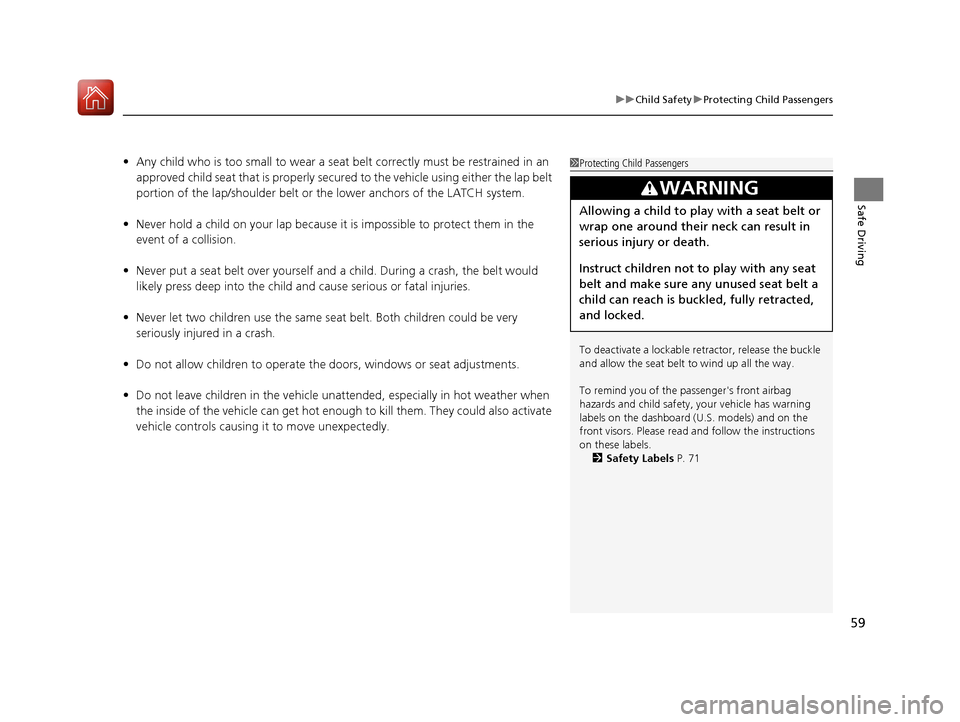
59
uuChild SafetyuProtecting Child Passengers
Safe Driving
•Any child who is too small to wear a seat belt correctly must be restrained in an
approved child seat that is properly secured to the vehicle using either the lap belt
portion of the lap/shoulder belt or the lower anchors of the LATCH system.
• Never hold a child on your lap because it is impossible to protect them in the
event of a collision.
• Never put a seat belt over yourself and a child. During a crash, the belt would
likely press deep into the child and cause serious or fatal injuries.
• Never let two children use the same seat belt. Both children could be very
seriously injured in a crash.
• Do not allow children to operate the doors, windows or seat adjustments.
• Do not leave children in the vehicle unattended, especially in hot weather when
the inside of the vehicle can get hot enough to kill them. They could also activate
vehicle controls causing it to move unexpectedly.1Protecting Child Passengers
To deactivate a lockable retractor, release the buckle
and allow the seat belt to wind up all the way.
To remind you of the pa ssenger's front airbag
hazards and child safety, your vehicle has warning
labels on the dashboard (U.S. models) and on the
front visors. Please read and follow the instructions
on these labels.
2 Safety Labels P. 71
3WARNING
Allowing a child to play with a seat belt or
wrap one around their neck can result in
serious injury or death.
Instruct children not to play with any seat
belt and make sure any unused seat belt a
child can reach is buckled, fully retracted,
and locked.
16 CIVIC 2D HC2 (0A 01 0C)-31TBG6000.book 59 ページ >0>.>/6年>0月>/>0日 金 曜日 午後4時>/6分